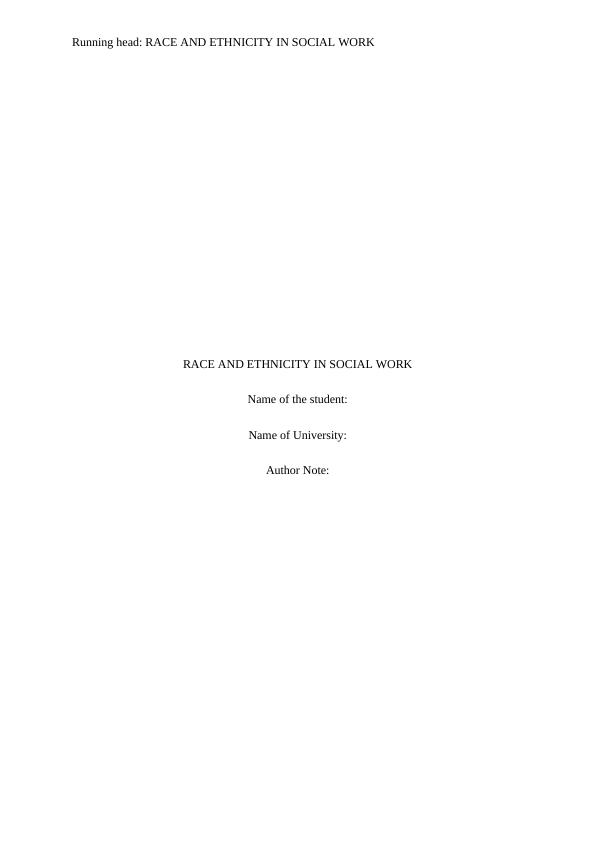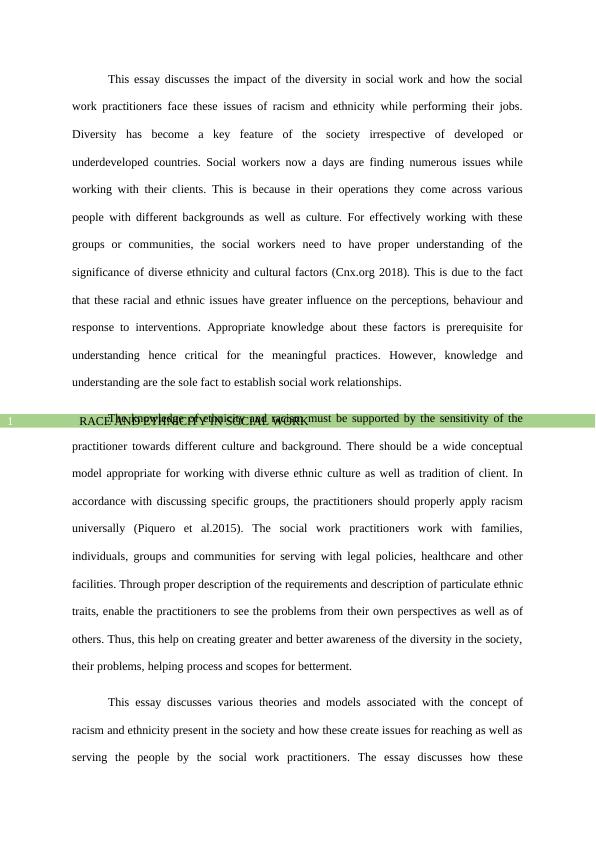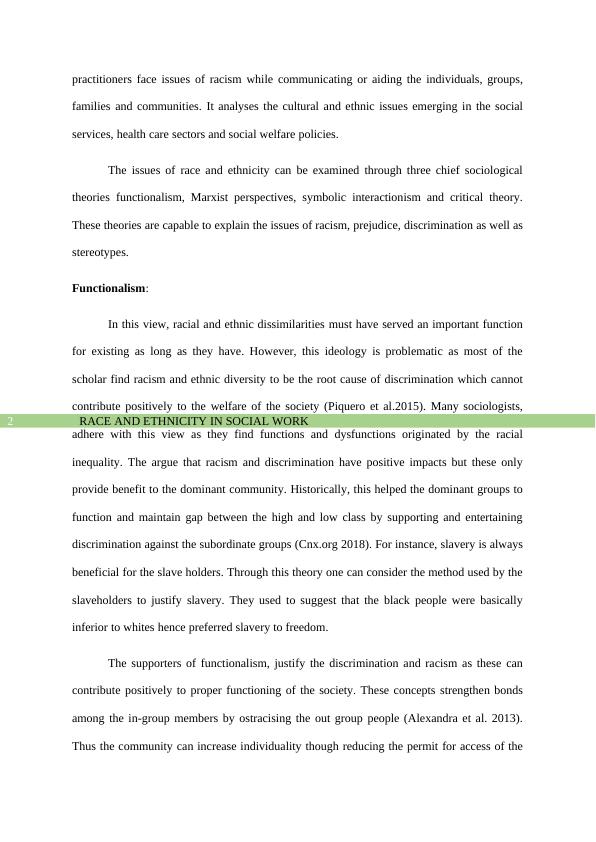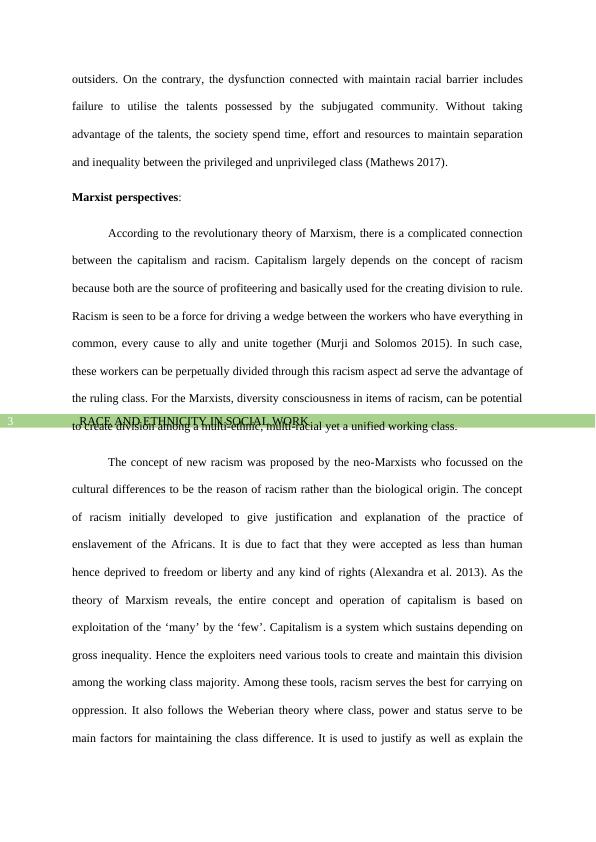(PDF) Diversity and social work practice
19 Pages5990 Words34 Views
Added on 2021-04-16
(PDF) Diversity and social work practice
Added on 2021-04-16
ShareRelated Documents
Running head: RACE AND ETHNICITY IN SOCIAL WORK
RACE AND ETHNICITY IN SOCIAL WORK
Name of the student:
Name of University:
Author Note:
RACE AND ETHNICITY IN SOCIAL WORK
Name of the student:
Name of University:
Author Note:

RACE AND ETHNICITY IN SOCIAL WORK1
This essay discusses the impact of the diversity in social work and how the social
work practitioners face these issues of racism and ethnicity while performing their jobs.
Diversity has become a key feature of the society irrespective of developed or
underdeveloped countries. Social workers now a days are finding numerous issues while
working with their clients. This is because in their operations they come across various
people with different backgrounds as well as culture. For effectively working with these
groups or communities, the social workers need to have proper understanding of the
significance of diverse ethnicity and cultural factors (Cnx.org 2018). This is due to the fact
that these racial and ethnic issues have greater influence on the perceptions, behaviour and
response to interventions. Appropriate knowledge about these factors is prerequisite for
understanding hence critical for the meaningful practices. However, knowledge and
understanding are the sole fact to establish social work relationships.
The knowledge of ethnicity and racism must be supported by the sensitivity of the
practitioner towards different culture and background. There should be a wide conceptual
model appropriate for working with diverse ethnic culture as well as tradition of client. In
accordance with discussing specific groups, the practitioners should properly apply racism
universally (Piquero et al.2015). The social work practitioners work with families,
individuals, groups and communities for serving with legal policies, healthcare and other
facilities. Through proper description of the requirements and description of particulate ethnic
traits, enable the practitioners to see the problems from their own perspectives as well as of
others. Thus, this help on creating greater and better awareness of the diversity in the society,
their problems, helping process and scopes for betterment.
This essay discusses various theories and models associated with the concept of
racism and ethnicity present in the society and how these create issues for reaching as well as
serving the people by the social work practitioners. The essay discusses how these
This essay discusses the impact of the diversity in social work and how the social
work practitioners face these issues of racism and ethnicity while performing their jobs.
Diversity has become a key feature of the society irrespective of developed or
underdeveloped countries. Social workers now a days are finding numerous issues while
working with their clients. This is because in their operations they come across various
people with different backgrounds as well as culture. For effectively working with these
groups or communities, the social workers need to have proper understanding of the
significance of diverse ethnicity and cultural factors (Cnx.org 2018). This is due to the fact
that these racial and ethnic issues have greater influence on the perceptions, behaviour and
response to interventions. Appropriate knowledge about these factors is prerequisite for
understanding hence critical for the meaningful practices. However, knowledge and
understanding are the sole fact to establish social work relationships.
The knowledge of ethnicity and racism must be supported by the sensitivity of the
practitioner towards different culture and background. There should be a wide conceptual
model appropriate for working with diverse ethnic culture as well as tradition of client. In
accordance with discussing specific groups, the practitioners should properly apply racism
universally (Piquero et al.2015). The social work practitioners work with families,
individuals, groups and communities for serving with legal policies, healthcare and other
facilities. Through proper description of the requirements and description of particulate ethnic
traits, enable the practitioners to see the problems from their own perspectives as well as of
others. Thus, this help on creating greater and better awareness of the diversity in the society,
their problems, helping process and scopes for betterment.
This essay discusses various theories and models associated with the concept of
racism and ethnicity present in the society and how these create issues for reaching as well as
serving the people by the social work practitioners. The essay discusses how these

RACE AND ETHNICITY IN SOCIAL WORK2
practitioners face issues of racism while communicating or aiding the individuals, groups,
families and communities. It analyses the cultural and ethnic issues emerging in the social
services, health care sectors and social welfare policies.
The issues of race and ethnicity can be examined through three chief sociological
theories functionalism, Marxist perspectives, symbolic interactionism and critical theory.
These theories are capable to explain the issues of racism, prejudice, discrimination as well as
stereotypes.
Functionalism:
In this view, racial and ethnic dissimilarities must have served an important function
for existing as long as they have. However, this ideology is problematic as most of the
scholar find racism and ethnic diversity to be the root cause of discrimination which cannot
contribute positively to the welfare of the society (Piquero et al.2015). Many sociologists,
adhere with this view as they find functions and dysfunctions originated by the racial
inequality. The argue that racism and discrimination have positive impacts but these only
provide benefit to the dominant community. Historically, this helped the dominant groups to
function and maintain gap between the high and low class by supporting and entertaining
discrimination against the subordinate groups (Cnx.org 2018). For instance, slavery is always
beneficial for the slave holders. Through this theory one can consider the method used by the
slaveholders to justify slavery. They used to suggest that the black people were basically
inferior to whites hence preferred slavery to freedom.
The supporters of functionalism, justify the discrimination and racism as these can
contribute positively to proper functioning of the society. These concepts strengthen bonds
among the in-group members by ostracising the out group people (Alexandra et al. 2013).
Thus the community can increase individuality though reducing the permit for access of the
practitioners face issues of racism while communicating or aiding the individuals, groups,
families and communities. It analyses the cultural and ethnic issues emerging in the social
services, health care sectors and social welfare policies.
The issues of race and ethnicity can be examined through three chief sociological
theories functionalism, Marxist perspectives, symbolic interactionism and critical theory.
These theories are capable to explain the issues of racism, prejudice, discrimination as well as
stereotypes.
Functionalism:
In this view, racial and ethnic dissimilarities must have served an important function
for existing as long as they have. However, this ideology is problematic as most of the
scholar find racism and ethnic diversity to be the root cause of discrimination which cannot
contribute positively to the welfare of the society (Piquero et al.2015). Many sociologists,
adhere with this view as they find functions and dysfunctions originated by the racial
inequality. The argue that racism and discrimination have positive impacts but these only
provide benefit to the dominant community. Historically, this helped the dominant groups to
function and maintain gap between the high and low class by supporting and entertaining
discrimination against the subordinate groups (Cnx.org 2018). For instance, slavery is always
beneficial for the slave holders. Through this theory one can consider the method used by the
slaveholders to justify slavery. They used to suggest that the black people were basically
inferior to whites hence preferred slavery to freedom.
The supporters of functionalism, justify the discrimination and racism as these can
contribute positively to proper functioning of the society. These concepts strengthen bonds
among the in-group members by ostracising the out group people (Alexandra et al. 2013).
Thus the community can increase individuality though reducing the permit for access of the

RACE AND ETHNICITY IN SOCIAL WORK3
outsiders. On the contrary, the dysfunction connected with maintain racial barrier includes
failure to utilise the talents possessed by the subjugated community. Without taking
advantage of the talents, the society spend time, effort and resources to maintain separation
and inequality between the privileged and unprivileged class (Mathews 2017).
Marxist perspectives:
According to the revolutionary theory of Marxism, there is a complicated connection
between the capitalism and racism. Capitalism largely depends on the concept of racism
because both are the source of profiteering and basically used for the creating division to rule.
Racism is seen to be a force for driving a wedge between the workers who have everything in
common, every cause to ally and unite together (Murji and Solomos 2015). In such case,
these workers can be perpetually divided through this racism aspect ad serve the advantage of
the ruling class. For the Marxists, diversity consciousness in items of racism, can be potential
to create division among a multi-ethnic, multi-racial yet a unified working class.
The concept of new racism was proposed by the neo-Marxists who focussed on the
cultural differences to be the reason of racism rather than the biological origin. The concept
of racism initially developed to give justification and explanation of the practice of
enslavement of the Africans. It is due to fact that they were accepted as less than human
hence deprived to freedom or liberty and any kind of rights (Alexandra et al. 2013). As the
theory of Marxism reveals, the entire concept and operation of capitalism is based on
exploitation of the ‘many’ by the ‘few’. Capitalism is a system which sustains depending on
gross inequality. Hence the exploiters need various tools to create and maintain this division
among the working class majority. Among these tools, racism serves the best for carrying on
oppression. It also follows the Weberian theory where class, power and status serve to be
main factors for maintaining the class difference. It is used to justify as well as explain the
outsiders. On the contrary, the dysfunction connected with maintain racial barrier includes
failure to utilise the talents possessed by the subjugated community. Without taking
advantage of the talents, the society spend time, effort and resources to maintain separation
and inequality between the privileged and unprivileged class (Mathews 2017).
Marxist perspectives:
According to the revolutionary theory of Marxism, there is a complicated connection
between the capitalism and racism. Capitalism largely depends on the concept of racism
because both are the source of profiteering and basically used for the creating division to rule.
Racism is seen to be a force for driving a wedge between the workers who have everything in
common, every cause to ally and unite together (Murji and Solomos 2015). In such case,
these workers can be perpetually divided through this racism aspect ad serve the advantage of
the ruling class. For the Marxists, diversity consciousness in items of racism, can be potential
to create division among a multi-ethnic, multi-racial yet a unified working class.
The concept of new racism was proposed by the neo-Marxists who focussed on the
cultural differences to be the reason of racism rather than the biological origin. The concept
of racism initially developed to give justification and explanation of the practice of
enslavement of the Africans. It is due to fact that they were accepted as less than human
hence deprived to freedom or liberty and any kind of rights (Alexandra et al. 2013). As the
theory of Marxism reveals, the entire concept and operation of capitalism is based on
exploitation of the ‘many’ by the ‘few’. Capitalism is a system which sustains depending on
gross inequality. Hence the exploiters need various tools to create and maintain this division
among the working class majority. Among these tools, racism serves the best for carrying on
oppression. It also follows the Weberian theory where class, power and status serve to be
main factors for maintaining the class difference. It is used to justify as well as explain the

End of preview
Want to access all the pages? Upload your documents or become a member.
Related Documents
Effect of Racism on Mental Health of First Nations Peoples and Interventionslg...
|7
|1852
|239
Sociological Foundationslg...
|8
|1838
|30
Racism and Discrimination in UK: Legislation, Case Law and Societal Opinionlg...
|8
|2411
|220
American Ethics: Race, Racism, and Discriminationlg...
|15
|3721
|385
Sociological Theorieslg...
|5
|893
|12
Relationship Between Racism and Sentencing: A Conflict Theory Perspectivelg...
|8
|1507
|136
